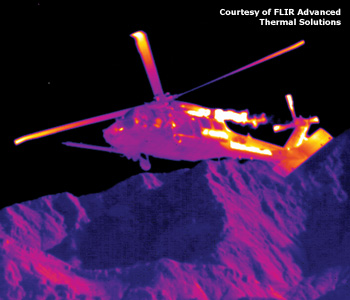 A Black Hawk helicopter is thermally imaged with a high-definition video camera at MWIR wavelengths near Nellis Air Force Base in Nevada.
A Black Hawk helicopter is thermally imaged with a high-definition video camera at MWIR wavelengths near Nellis Air Force Base in Nevada.
Global defense budgets are subject to cuts like everything else, with so many countries experiencing debt and looming austerity measures at home. In addition to the ever-present demand to reduce size, weight and power, the trend in the military and defense industry is to develop technology that cuts costs—in other words, to do more with less. This means companies are not only tight-lipped about disclosing the secrets of military technology (as usual), but that they are even more guarded about the proprietary advances that make them competitive. While the specifics are hard to pin down, the trends are evident.
The infrared (IR) wavelengths are an important focus of military and defense research and development because so much of surveillance and targeting occurs under the cover of darkness. A seemingly impossible task such as imaging a threat moving behind foliage at night is made possible by new developments in IR technology, including sensors fabricated using novel materials, decreased pixel pitch (the center-to-center distance between pixels) and improved cooling and vacuum technology.
The infrared spectrum, adjacent to the visible part of the spectrum, is split into four bands: near-, short-wave, mid-wave, and long-wave IR, also known by the abbreviations NIR, SWIR, MWIR and LWIR. The NIR portion of the spectrum is typically defined as ranging from the end of the visible spectrum around 900 nm to 1.7 µm. The SWIR portion of the spectrum ranges from 1.7 µm to 3 µm or so. Glass lenses can transmit from visible through the NIR and SWIR region. The SWIR region bridges the gap between visible wavelengths and peak thermal sensitivity of infrared, scattering less than visible wavelengths and detecting low-level reflected light at longer distances—ideal for imaging through smoke and fog. Also, SWIR imaging occurs at 1.5 µm, which is an eye-safe wavelength preferred by the military.
Detector materials
Imaging in the IR can involve a wide range of detectors or sensors. Uncooled microbolometers can be fabricated from vanadium oxide (VOx) or amorphous silicon. Indium gallium arsenide (InGaAs) and germanium (Ge) are common in IR sensors. But these semiconductor materials are expensive: a glass lens for visible imaging that costs $100 may cost $5,000 for Ge in the IR, according to Chris Bainter, senior science segment engineer at FLIR Advanced Thermal Solutions (South Pasadena, Calif, U.S.A.). So reducing cost is of the utmost importance.
One critical way to do that is to squeeze more pixels onto each sensor, reducing the pixel pitch (the center-to-center distance between pixels) while maintaining performance. Currently, sensors with 15- and 12-µm pixel pitch are in the development stage in several places, and they have even been demonstrated at SWIR, MWIR and LWIR wavelengths using mercury cadmium telluride (HgCdTe or MCT, also called CMT in Europe) and indium antimonide (InSb) with simple readout integrated circuits. A nonexhaustive list of companies pursuing 15-µm pitch sensors includes Raytheon (Waltham, Mass., U.S.A.), Goodrich/Sensors Unlimited (Princeton, N.J., U.S.A.), DRS Technologies (Parsippany, N.J., U.S.A.), AIM INFRAROT-MODULE GmbH (Heilbronn, Germany), and Sofradir (Châtenay-Malabry, France). The technology has come a long way in a short time to improve performance, noise and array size, but many barriers remain.
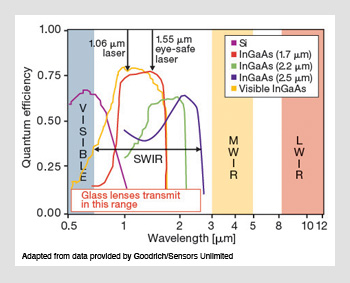 Wavelength response for various visible/IR detector materials
Wavelength response for various visible/IR detector materials
For now, next-generation systems for defense are moving to 17-µm pitch. The Reconnaissance, Surveillance and Target Acquisition (RSTA) group at DRS Technologies (Dallas, Texas, U.S.A.) has developed a VOx uncooled focal-plane array (UFPA) consisting of 17-µm pixel-pitch detectors measuring 1,024 × 768. The imager, called U8000, was developed for the Army for use in next-generation military systems such as thermal weapon sights, digitally fused enhanced night-vision goggles, driver's vision enhancers and unmanned aerial systems.
The 17-µm-pixel-pitch UFPA provides sensor systems with size, weight and power (SWaP) savings as well as cost advantages over existing devices. To meet the market demand, DRS has improved its production facilities to accommodate 17-µm-pixel detector manufacturing. In addition, DRS has also developed new signal-processing technology based on field-programmable gate-array architecture for U.S. Department of Defense weapon systems as well as commercial original equipment manufacturer cameras.
The microbolometer sensor used in the U8000 is a key enabling technology. Sensitive to the LWIR range between 7 to 14 µm, microbolometers are detector arrays with sensors that change their electrical resistance upon detection of thermal infrared light. Microbolometers detect temperature differences in a scene, so even when no illumination exists, an object that generates heat is visible.
Image fusion
Under the DARPA-funded DUDE (Dual-Mode Detector Ensemble) program, DRS and Goodrich/Sensors Unlimited are codeveloping an integrated two-color image system by combining a VOx microbolometer (for 8 to 14 µm) and InGaAs (0.7 to 1.6 µm) detectors into a single focal plane array.
Other two-color work at DRS includes the distributed aperture infrared countermeasure system. "The small system uses a two-color sensor to detect and track a missile launch while directing a laser to defeat it," says Mike Scholten, vice president of sensors at DRS's RSTA group.
On the materials side, says Scholten, one of the key enabling technologies is HgCdTe (MCT), which is tunable to cutoff wavelengths from the visible to the LWIR. Heavier cooled systems are used in tanks and helicopters for targeting and in base outpost surveillance and high-altitude reconnaissance from aircraft. "Because of the higher operating temperatures of MCT, we can reduce the size, weight and power of systems in helicopters and aircraft," says Scholten.
Cooled systems can now offer higher performance with cryogenic coolers for long-range applications. "The SWaP characteristics of a cooled system are now reduced enough for battery-operated handheld systems," says Scholten. "At the same time, uncooled system performance has also increased dramatically year after year, so the performance gap is closing from both ends."
 Providing the third spatial dimension required to create a 3-D image. Each pixel in the Princeton Lightwave 3-D image sensor records time-of-flight distance information to create a 3-D image of surroundings.
Providing the third spatial dimension required to create a 3-D image. Each pixel in the Princeton Lightwave 3-D image sensor records time-of-flight distance information to create a 3-D image of surroundings.
Vacuum packaging and cooling technology have also changed for the better. "On the vacuum side," says Scholten, "we design and build our own cryogenic coolers." A combination of the MCT sensor and working in the MWIR allows the RSTA group to tune and operate at a higher operating temperature. MCT has predominantly been long wave, but the higher-operating-temperature MWIR is now possible, Scholten says. "Having to cool the sensor to 120 K rather than 85 K, which is the requirement for InSb, we can do a smaller vacuum package that doesn't draw as much power."
Identification
"Detection is only the first step of the military's surveillance and reconnaissance technology," says Bora Onat, technical program manager/business development at Princeton Lightwave (PLI; Cranbury, N.J., U.S.A.). Recognition is the second step—in other words, the ability to discriminate between a man and something else, such as a cow or deer. The third step, identification, involves being able to discern whether a person is friend or foe, which is key in advanced IR imaging today.
According to Onat, "Long-wave IR imagers, which sense thermal signatures, provide excellent detection capability in low-light-level conditions." However, they don't provide enough information, he says. Conventional long-wave IR imagers enable soldiers to detect targets from very far distances, but they can't identify them. In order to do that, you need visible or SWIR wavelengths, which detect ambient light reflected off the object. "These technologies use a detector array to sense the reflected light and enable easier recognition and identification of distant objects from features such as the clothing on humans or the structural details of a truck."
Geiger-mode APDs
Princeton Lightwave is in pilot production of a 3-D SWIR imager using Geiger-mode avalanche photodiodes (APDs) based on the technology developed at MIT Lincoln Labs as a result of a DARPA-funded program. "While Geiger-mode APDs aren't a new technology, we successfully applied our SWIR APD technology to 3-D imaging thanks to our superb detector uniformity," according to Onat. The technology enables long-range identification through common battlefield obscurants such as smoke, fog, foliage and camouflage," he says.
The imager features arrays of APDs flip-chip bonded to a special readout integrated circuit (ROIC). The system launches an optical pulse to the target object at a single wavelength (either NIR at 1,064 nm, or eye-safe SWIR at 1,550 nm). The ROIC records the time-of-flight information for each APD pixel of the array (much like light detection and ranging, or LIDAR). This accurate distance information incorporated in every pixel provides the third spatial dimension required to create a 3-D image.
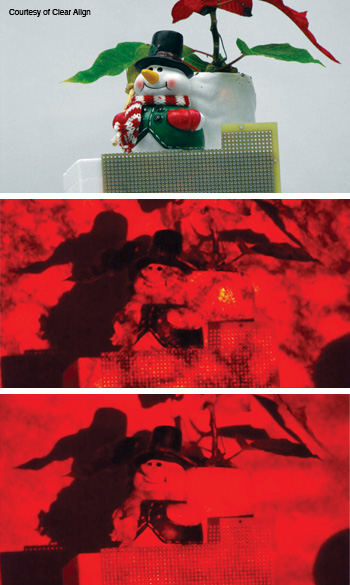 A seasonal scene in visible lighting. The scene (top) is illuminated with a helium-neon (HeNe) laser with no speckle reduction (center) and with a HeNe laser with speckle reduction (bottom).
A seasonal scene in visible lighting. The scene (top) is illuminated with a helium-neon (HeNe) laser with no speckle reduction (center) and with a HeNe laser with speckle reduction (bottom).
The reconstructed scene returns better information for identifying, for example, the markings on a truck, car or tanker to help discern whether it's friendly or not. PLI's commercial 3-D focal plane array (FPA) image sensor has a 32 × 32 format with 100-µm pitch, and they have demonstrated prototype FPAs using four times as many pixels in a 32 × 128 format with half the pitch, at 50 µm. "The limiting factor here for the FPA format was the pixel pitch dictated by the ROIC. With better (smaller) silicon fabrication processes, we could improve resolution even more."
Single-photon detection is the key to this 3-D IR imaging technology. "In a conventional APD, the voltage bias is set to a few volts below its breakdown voltage, exhibiting a typical gain of 15 to 30," says Onat. In Geiger-mode operation, he continues, the device is biased above its avalanche breakdown voltage for a fraction of a second. "This creates an exponential increase in gain and the absorption of just a single photon can lead to a macroscopic avalanche current pulse that is easily detected by backend electronic circuitry, so that single-photon detection is the mechanism."
The temperature range for the Geiger-mode APD is typically –30° C, explains Onat, which is attainable by a two-stage solid-state thermo-electric cooler to keep it stable at 240 K. This keeps the APDs cool in order to reduce the number of thermally generated electrons that could set off the APD and cause a false trigger when photons are not present.
The ability to use single-photon detection for imaging through foliage or camouflage netting has been around for more than a decade in visible wavelengths," says Onat. "The goal is to use more eye-safe 3-D IR imaging technology that can be easily deployed in the battlefield by mounting on UAVs and helicopters.
Illumination
When light levels are too low for sensors to detect light, scene illumination becomes critical in IR imaging. Efficiently shedding light on a scene is typically accomplished with lasers. Clear Align (Eagleville, Pa., U.S.A.) offers a newly patented technology called "Illuminate," which uniformly illuminates a subject, eliminating laser speckle in IR imaging. Speckle is an interference effect that occurs when coherent laser light is used to illuminate uneven surfaces. The Illuminate system is designed for use in the visible, NIR, SWIR and MWIR regions or in a combination of all four. "We do a lot of business for laser illumination in SWIR for nonvisible eye-safe wavelengths," says Angelique X. Irvin, president and CEO of Clear Align.
Speckle can be classified as either objective or subjective. Subjective speckle is formed when coherent light reflecting off a three-dimensional image interferes in the image plane. Objective speckle is created by coherent light that has been scattered off a three-dimensional object and is imaged on another surface. Clear Align's proprietary Illuminate technology can reduce or eliminate both forms of speckle.
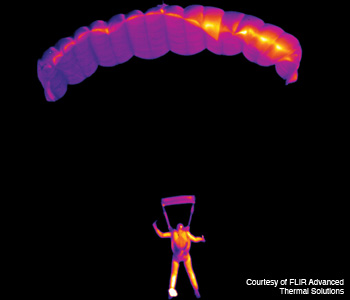 Parachute activity is captured in this high-speed, high-resolution MWIR HD-video image near Nellis Air Force Base in Nevada.
Parachute activity is captured in this high-speed, high-resolution MWIR HD-video image near Nellis Air Force Base in Nevada.
Other products for IR imaging from Clear Align include the INSPIRE family of preengineered SWIR lenses for high-resolution imaging. INSPIRE lenses have internal surfaces covered with proprietary antireflection coatings with a reflection of less than 0.5 percent in the SWIR wavelength region. This eliminates "flare" from SWIR images. Clear Align's novel "Featherweight" housing material enables a 25 percent overall weight reduction compared to existing lens assemblies while maintaining temperature-stable performance from –40° C to 120° C, the extremes of the operating temperature range.
MWIR
Another material used in detectors, InSb, has peak responsivity from 3 to 5 µm, so it is common for use in MWIR imaging. FLIR Advanced Thermal Solutions is vertically integrated, which means they grow their own indium antimonide (InSb) detector material and hybridize it on their FLIR-designed ROICs. The InSb sensor is then built into a closed-cycle dewar with a Stirling engine that cools the detector to near cryogenic levels, typically about 77 K.
The latest development at FLIR, according to Bainter, is high-speed, high-resolution IR video for surveillance, tracking and radiometry on government test ranges. The SC8200 HD video camera has a square 1,024 × 1,024 pixel array, while the SC8300 with a 1,344 × 784 array is rectangular, similar to the format used in movies. The 14-bit digital stream allows for capture of quantitative data at more than 130 frames per second of high-definition (HD) video output. "Sometimes an application involves qualitative imaging of an object's thermal signature," says Bainter. "But in most cases, the idea is to measure radiance (radiometry) or temperature to see the heat signature."
The HD video cameras can be installed on tracking mounts that use IR to lock on a target and provide high-speed tracking through the sky or on the ground. The speed of this mount determines how fast a target can be monitored—whether it can track planes or missiles. For tracking long distances through the atmosphere, the MWIR range at 3 to 5 µm is ideal. Infrared imaging works during the day or at night, so the cameras register heat contrast against a mountain or the sky, which is tough to do in visible wavelengths.
In April 2011, FLIR plans to announce a new high-definition IR camera billed as "1K × 1K for under $100K." This basic version of the SC8200 and SC8300 series cameras will include "ExaminIR" software, a 50-mm lens, and thermographic calibration from 0° C to 500° C for $99,500. It will have a 40-Hz full-window frame rate, and it will eliminate external inter-range instrumentation group time code B sync and generator-locking synchronization (genlock sync—the synchronization of two video sources to prevent image instability when switching between signals).
One trade-off is that high-def IR cameras are traditionally expensive: The cost increases with the number of pixels. The detector requires a wafer with an exceptional amount of pixel integrity. High-end specialized arrays can be as large as 3000 × 3000. "Due to higher government demand for the 1K × 1K detectors, we are able to increase our volumes and consequently improve our manufacturing yields, resulting in lower costs," says Bainter. "FLIR can now offer a better product at commercial prices nearly half of what they were two years ago, allowing commercial research and science markets to take advantage of the improved sensitivity, resolution and speed."
The other tradeoff is that the IR optics are a design challenge. With visible optics, the f# is usually defined by the optics. At IR wavelengths, the detector must be cooled to 77 K, so the f-stop is actually inside the dewar. "If not designed properly, the optical blur spot can go across more than one pixel," says Bainter. "Since the pixel sizes are typically smaller in high definition detectors, the risk of having this happen is higher, which would create a softening of your image."
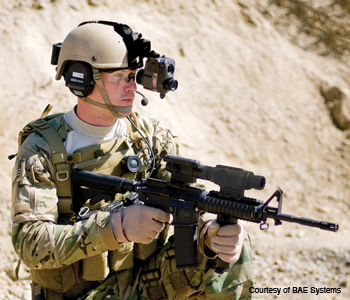 The night-vision goggle under development at BAE Systems digitally combines video imagery from a low-light-level sensor and an uncooled LWIR (thermal) sensor on a single color display located in front of the user's eye, mounted to a helmet or hand-held.
The night-vision goggle under development at BAE Systems digitally combines video imagery from a low-light-level sensor and an uncooled LWIR (thermal) sensor on a single color display located in front of the user's eye, mounted to a helmet or hand-held.
Fusing wavebands
LWIR technology is used in thermal weapons sights, advanced night-vision goggles and vehicles to enhance driver vision. According to Susan Palmateer, director of technology programs at BAE Systems Electronic Solutions (Lexington, Mass., U.S.A.), BAE Systems is combining LWIR and low-light-level (0.3 to 0.9 µm) wavebands in the development of night-vision goggles using digital imaging. "The use of digital sensors in enhanced night-vision digital goggles improves performance over prior generations' analog technology." The Army is expecting to field new and improved digitally fused imaging goggles by 2014. The goggles, which use VOx microbolometer detectors, provide the "dismounted war fighter" with reflexive target engagement up to 150 m away when used with currently fielded rifle-mounted aiming lights.
"It's always about SWaP-C—size, weight and power, cost," says Palmateer. "The next-generation technology involves larger format arrays, smaller pixels and fusing the imagery of different spectral bands."
"Achieving the cost part of the equation means the use of six-sigma and lean manufacturing techniques. Cost-competiveness is where the challenge is," says Richard Blackwell, detector technologist at BAE Systems. "That's really where a lot of the push is now with decreasing defense budgets—and getting this technology in the hands of our war fighters."
Rheinmetall Canada (Montreal, Canada) will integrate BAE Systems' uncooled thermal weapon sights into the fire control system of the Canadian Army's 40-mm grenade launcher. The thermal weapon sights are able to image small-temperature differences in the scene, enabling targets to be acquired in darkness and when obscurants such as smoke are present. The "MicroIR" uncooled VOx microbolometer sensor on the sights eliminates the need for bulky, power-hungry cryogenic coolers.
What next in the market? "Getting cost down," says Irvin at Clear Align. "Making products that are lower cost in SWIR in particular." Given that budgets are very limited, Irvin says, bringing cost down is going to require innovation and volume production. "Camera companies are under a lot more pressure to come up with lower-cost solutions that perform well."
Valerie C. Coffey is a freelance science and technology writer and editor based in Boxborough, Mass., U.S.A.
References and Resourcess
>> R. Blackwell et al. "Uncooled VOx thermal imaging systems at BAE Systems," Proc. of SPIE Vol. 6940, Infrared Technology and Applications XXXIV (2008).
>> J. Keller. "Night-vision devices to blend infrared technology, image intensifiers," Military & Aerospace Electronics (2008).
>> H. Yuan et al. "FPA development: from InGaAs, InSb, to HgCdTe," Proc. of SPIE Vol. 6940, Infrared Technology and Applications XXXIV (2008).
>> A. Rogalski. Fundamentals of Infrared Detector Technologies, Google e-Book, CRC Technologies (2009).
>> Clear Align: High-Performance Pre-Engineered SWIR lenses (2010).
>> Defense Update (2010).
>> DRS Technologies. "Answers to Questions on MCT's Advantages as an Infrared Imaging Material" (2010).
>> L.G. Melkonian et al. "The performance of MWIR and SWIR HgCdTe-based focal plane arrays at high operating temperatures," Proc. of SPIE Vol. 7660, Infrared Technology and Applications XXXVI (2010).
>> G. Overton. "IMAGE FUSION: Hinted SWIR fuses LWIR and SWIR images for improved target identification," Laser Focus World (June 2010).
>> Goodrich Corp. "Technology: Why SWIR? What is the Value of Shortwave Infrared?" (2011).
>> C. Li et al. "Uncooled VOx infrared sensor development and application," Proc. SPIE 8012, Infrared Technology and Applications XXXVII (2011).
